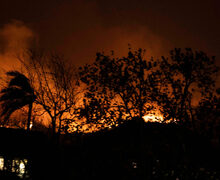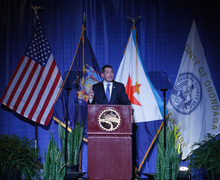Roth: Adventures abroad detach columnist from life at home
I’m not always a fan of social media, but I owe it to Facebook that I’m still connected to life in the United States. Without my friend’s Facebook status reading, “CUUUUUUUUUUUUUSE,” I probably would have forgotten that Syracuse University is starting its first week of classes.
My semester at Pontificia Universidad Católica in Santiago, Chile started three weeks ago and I’ve been abroad in South America for about two months now. My group of 20 started in Cuenca, Ecuador for a month-long, language immersion experience.
After picking up three Spanish credits, seeing the equator and hiking through a national park, seven more students joined us when we arrived in Santiago, Chile. Then, our two professors showed us through Buenos Aires, Argentina and Montevideo, Uruguay.
With all of this traveling, I’m beginning to feel more disconnected with home. The time zone is the same as the east coast, but it’s winter here. The winter feels more like spring, reaching 60–70 degrees in the afternoon and 40 degrees in the evening. When I Facetime my family and hear crickets in the background, it’s like I can feel the humidity of Pennsylvania’s summer. I forget what month it is a lot.
With my fourth week under my belt, I’m settled in with my host family in Santiago. I know the city well enough to not get lost on the metro. I’m picking up on the Chilean slang and I felt my first earthquake Saturday evening — a 6.4.
Because Chile stretches along the west coast of South America, the geography ranges from the world’s driest desert in the north, the Andes Mountains along the east, Patagonia in the south and the Pacific Ocean along the west.
My goal is to travel the country in all four directions, and my past two weekends were spent in the Pacific Ocean and the Andes Mountains.
Santiago is in the center of it all.
With a capital city of 6 million — twice the size of Los Angeles — Chile is an ironic mix of urbanization and desolation, which is exactly why I chose to come here. Eighty-five percent of the country’s population lives in urban areas. Santiago’s surrounding area is peppered with houses and vineyards, but it’s mostly desolate natural beauty.
Santiago is a cosmopolitan maze of metros, busses and suited-up people walking somewhere important. There are enough McDonald’s, sushi restaurants and smog for everyone in the city.
But as quickly as I can get wrapped up in the rushed city life, I can leave it. It’s an hour east to the beach and an hour west to the Andes Mountains.
On Friday, my friend and I donned our snow pants and headed to El Dorado to ski through a program with about 30 international students. We drove on Route 40, which is said to have 40 switchbacks. This is probably true sinceEl Colorado is between 8,000 and 10,000 feet in altitude, while Santiago is at about 2,000 feet.
With these huge, bare mountains in the distance, it felt like the only thing that existed was this ski resort. The rest of the world simply had fallen off. Or, rather, I had simply fallen off the world.
But sure enough, after another hour-long drive, we were back to city life and I was taking the metro to my host family’s house.
I recounted my day to my host family, then I Facetimed my real family. Soon enough, I was reconnected with the familiar senses of summertime — crickets chirping in my backyard and my friend eating Oreo ice cream.
Danielle Roth is a junior majoring in magazine journalism and international relations. She is following her desires for good food and adventure in Santiago, Chile. Email her at dlroth@syr.edu or tweet at her @danielleroth_ .
Published on August 26, 2014 at 12:01 am





